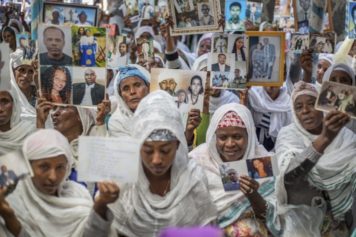
Israelis take part in a demonstration in Tel Aviv called by members of the Ethiopian community against alleged police brutality and institutionalized discrimination, on May 3, 2015.
(JACK GUEZ/AFP/GETTY IMAGES)
How do the oppressed respond to racism and how differently does each group respond depending on the country they live in? The authors of a new book explore the answers to these questions in a thought-provoking work that has implications for studying and addressing discrimination.
In “Getting Respect: Responding to Stigma and Discrimination in the United States, Brazil and Israel,” the authors conducted an eight-year sociological study of 400 working- and middle-class people from five minority groups in three countries: African-Americans in New York, Afro-Brazilians in Rio de Janeiro, and Palestinian Arabs and Ethiopian and Mizrahi Jews in Israel. The interviewees included people who experienced discrimination (“being deprived of resources”) and those who dealt with stigmatizaton (“being assigned low status.”)
“When asked about incidents where they were treated unfairly, these individuals described interactions where they felt underestimated, misunderstood, feared, overlooked, shunned or discriminated against,” the authors wrote. “They discussed their responses, including how they confronted their stigmatizers, aimed to avoid confirming racial stereotypes, used humor and chose to ignore the incident, often motivated by a desire to get respect.”
In one case, an African-American man named Joe finds himself in an elevator with several white men at work. One of the men tells a joke about monkeys and Black people, causing Joe to become understandably stressed. Yet, he does not respond or react angrily because he has been on the job for only a week and does not want to be fired.
One of the authors of the book, Michèle Lamont — a professor of sociology and African and African-American studies at Harvard University, director of the Weatherhead Center for International Affairs and the Robert I. Goldman Professor of European Studies — told Atlanta Black Star that the inspiration for the research came from an earlier work in which she compared Black and white workers in New York to North African and white workers. Both African-Americans and North African immigrants are victims of racism in their respective societies, she noted, yet have different perceptions of equality.
“One of the questions was, ‘What makes people equal?’ In the U.S., people talked a lot about money making people equal. If you can buy a house and I can buy a house, we’re equal. Whereas in France, no one ever said that. It was more like human nature is the same across groups or we’re equal citizens. So, I really felt like there was much more to be studied there,” Lamont told Atlanta Black Star.
In addition to having an interest in conceptions of equality, the Harvard professor and current president of the American Sociological Association also was interested, as a comparativist, in examining experiences of stigmatization and discrimination.

Michèle Lamont, Professor of Sociology and of African and African American Studies, Harvard University, and the Robert I. Goldman Professor of European Studies at Harvard University. She serves as the 108th President of the American Sociological Association in 2016-2017. www.michelelamont.org/
The approach in “Getting Respect,” Lamont noted, was not merely to begin with the notion that every stigmatized minority group experiences racism but rather to get a sense of the “texture” of it across nations and how their experiences are explained by the context in which people live. It was important to understand the degree to which groups are in contact with each other, how much they interact and intermarry and the like. “So, it was not only a question of understanding variations in experiences of racism but also how can we account for it,” she said.
According to the Harvard sociologist, the authors’ first objective was to try to understand how the phenotype of Blackness is associated with different experiences in the three countries studied.
“You cannot presume that you know that being Black is interpreted the same across places,” Lamont said. “So, basically, what we argue in the book is that African-Americans have access to scripts and stories about the history of their group, which makes them much more clear-minded when it comes to experiencing something that they will attribute to racism, because it is so widely discussed in American society, this experience.”
In Brazilian culture, by contrast, it is considered rude to make race a salient, integral part of your interactions with other people, she said. “The only context under which people would feel free to say, ‘What you’re doing, that was racist’ is if the N-word was used, if something very explicit was done,” Lamont said.
Ethiopian Israelis, on the other hand, as Jewish immigrants want to assimilate into Israeli society, researchers said. And while they face blatant racism and do respond to that discrimination, their response is less confrontational and motivated by what Lamont describes as a desire to move up in society.
While the book explores the fascinating topic of international racism and how different groups are stigmatized based on their Blackness, there are other groups discussed in the book that face racism not based on physical appearance or color but on other life circumstances that are shaped by politics.
Arab-Israelis (Israelis citizens of Arab descent as opposed to Palestinians in the occupied territories), for instance are “not stigmatized on the basis on their phenotype because they’re physically indistinguishable from the others,” Lamont said. “But, people can quickly recognize when they talk, their accent or they carry their body a little differently and they are rejected because they are perceived as allied with Palestinians, who are viewed as terrorists.
“You cannot just understand their experience, you have to understand their place in the national polity to make sense of what they live.”

Resistencia Poetica is an anti-racism and anti-police-violence group that performs on buses, in the metro and in public spaces to raise awareness about the mistreatment of black people in Brazil’s black capital, Salvador.
FAHEMA GABR
Then, there are the Mizrahim (Israelis who are Jewish and of Arab descent) coming from countries such as Yemen and Iraq. “The case of the Mizrahi is a little different because they’re also Jewish and feel that they’re fully part of the country because it’s a Zionist country that says everyone who is Jewish is welcome and belongs,” Lamont said. “But at the same time the Ashkenazi Jews, the European Jews who created the state of Israel, tend to look down on the Mizrahim because their family comes from the Middle East … and are perceived as being backward.”
Lamont added that although they are concentrated at the bottom of the Israeli socioeconomic structure and face exclusion like Black Brazilians and African-Americans, the Mizrahim pride themselves on their social integration and tend to be less confrontational. They speak of racism not as something that they experience, but as something in the past or something that happens to other people.

Palestinian kids hold up a sign in solidarity with Eric Garner and U.S. protesters for racial justice. Photo by Hamdi Abu Rahma.
Even as each of the five groups covered in the book has its own experience with oppression and legacy of resistance, there has been cross-pollination and influencing among them. For example, in the 1970s, the Mizrahim formed their own Black Panthers, a protest movement modeled after the African-American social justice organization. And in recent years, Palestinian activists showed solidarity with Black protesters in Ferguson, even giving them advice via social media on how to deal with police tear gas. This, as Ethiopian Israelis protest against police violence in the streets of Tel Aviv and proclaim that Black Lives Matter.
Lamont said that the transnational transfer of ideas and models on how to deal with racism were important to her study. “There are a lot of cultural exchanges between the three countries, the civil rights movement in the U.S. and Black Lives Matter, etc. The massive mobilization that we see in the U.S. has a lot of implications abroad. So, for instance, in the context of Brazil, there’s been a lot of reactions to the Black Lives Matter movement because there’s massive police violence in Brazil, but there’s very little mobilization against it,” Lamont noted. “So, when they saw this massive mobilization in the U.S., a lot of people there started saying, ‘[Why do] we experience much worse than them, yet no one mobilizes?’ So, there’s a kind of transnational exchange and learning lessons across places.”
Lamont said that while some of this exchange takes place through the media, there is also the example of the Durban conference, which led to Brazil creating anti-discrimination agencies and an anti-discrimination industry that had not existed. “So, it has to be the case that countries learn from each other, and also I gathered that Black Lives Matter took on the Palestinian cause and said, ‘This is racism as well.”
Lamont says there are a few lessons that readers should learn from “Getting Respect” and its subject matter on racism. The first is that while much of the literature on racism in the U.S. centers around African-Americans, what is not as prominent is a focus on the universal experience of stigmatization. This book examines the African-American experience through the lenses of other national contexts, which Lamont believes is useful. And while some readers may know absolutely nothing about Israel or Brazil, the real-life stories and the feelings of the people in the research sound familiar.
Further, the book is written with white people in mind, those who do not understand what Black people face on a daily basis and lack a proper context to appreciate the impact of racism.
“Educating the ignorant” emerged as an important theme throughout the research for this book, according to Lamont. “People get extremely worked up, because with racism comes a sense that people’s dignity is really being challenged. The victims of racism feel like they’re not fully recognized for their words, and the people who feel like they’re being denounced for being racist feel like they are being given lessons in a way that is unfair because they don’t think of themselves as racist, even if they are.”
Given the extremely high level of racial segregation in the U.S., many white people have no idea about the lives of African-Americans, Lamont said. “So, the book is also written to bring this to light for them, to really show, well yes, it’s understandable that people are really pissed off,” she said. “That’s the kind of thing that they have to deal with on a daily basis.”


